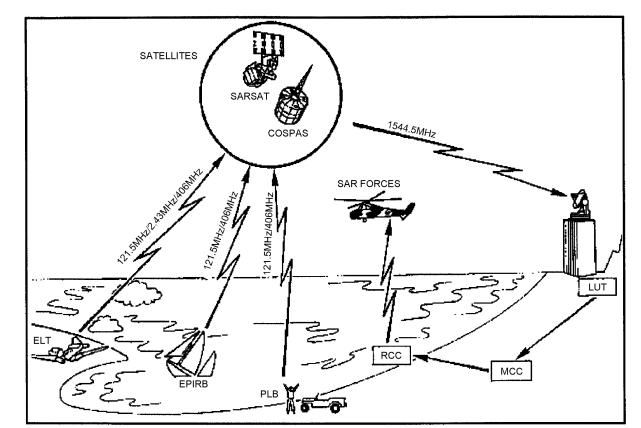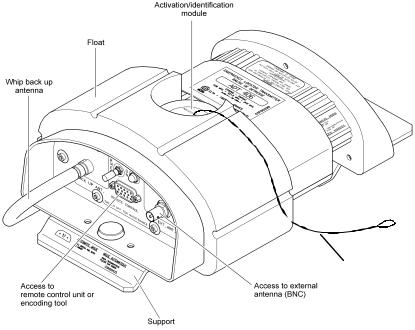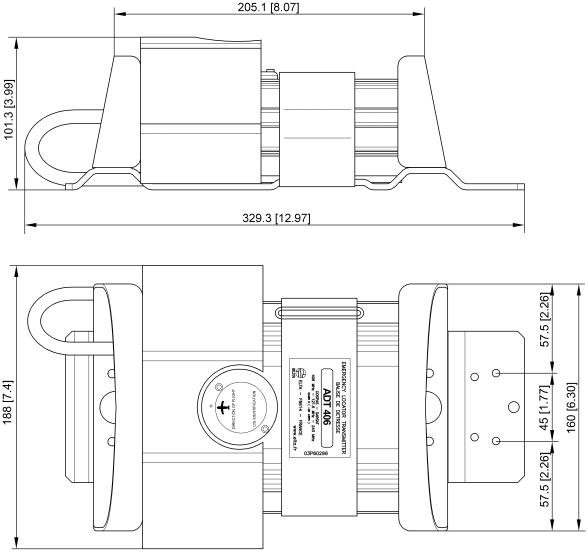ELTA ADT406 Manual

 86(5¶6 +$1'%22.
86(5¶6 +$1'%22.
86(5¶6 +$1'%22. ,1&/8',1* ,167$//$7,21 0$18$/ $1' /2* %22.
SERIAL NUMBER LABEL
(0(5*(1&< /2&$725 75$160,77(5 02'(/ $'7 $3 ,1 7+( &263$6 6$56$7 6<67(0
Issued by
(/7$ )
14 Place Marcel Dassault
31702 BLAGNAC
France www.elta.fr
Documentation P/N: 03E61013 Rev B |
Title Page |
Initial issue: Feb 15/03 |
Apr 17/03 |

 86(5¶6 +$1'%22.
86(5¶6 +$1'%22.
|
|
|
LIST OF UPDATES |
|
|
|
|
||
|
|
|
|
|
|
|
|
|
|
UPDATE |
ISSUE |
INSERTION |
|
UPDATE |
ISSUE |
INSERTION |
|
||
No. |
DATE |
BY |
|
No. |
|
|
BY |
||
|
|
|
DATE |
|
|||||
|
|
|
|
|
|
||||
A |
INITIAL |
Feb 15/03 |
E.LABRIFFE |
|
|
|
|
|
|
B |
|
Apr 17/03 |
E.LABRIFFE |
|
|
|
|
|
|
|
|
|
|
|
|
|
|
|
|
Page 1
Apr 17/03
 86(5¶6 +$1'%22.
86(5¶6 +$1'%22.
PAGE INTENTIONALLY LEFT BLANK
Page 2
BLANK

 86(5¶6 +$1'%22.
86(5¶6 +$1'%22.
LIST OF EFFECTIVE PAGES
CHAPTER/
SECTION
TITLE PAGE
LISTE OF UPDATES
LIST OF EFFECTIVE PAGE
TABLE OF ILLUSTRATIONS
LEADING PARTICULARS
TABLE OF CONTENTS
PAGE DATE
Apr 17/03
1Apr 17/03
2BLANK
3Apr 17/03
4BLANK
5Feb 15/03
6BLANK
7Feb 15/03
8BLANK
9Feb 15/03
10BLANK
11Feb 15/03
12Feb 15/03
13Feb 15/03
14Apr 17/03
15Apr 17/03
16Apr 17/03
17Apr 17/03
18Apr 17/03
19Feb 15/03
20Apr 17/03
21Feb 15/03
22Feb 15/03
23Feb 15/03
24Feb 15/03
25Feb 15/03
26Apr 17/03
27Feb 15/03
28Apr 17/03
29Apr 17/03
30Apr 17/03
31Apr 17/03
32Feb 15/03
33Feb 15/03
34Apr 17/03
CHAPTER/
SECTION
Appendix A
Appendix B
PAGE DATE
1Feb 15/03
2Feb 15/03
3Feb 15/03
4Feb 15/03
5Feb 15/03
1Feb 15/03
2Feb 15/03
3Feb 15/03
4Feb 15/03
5Feb 15/03
6Feb 15/03
7Feb 15/03
8Feb 15/03
9Feb 15/03 10 Feb 15/03 11 Feb 15/03 12 Feb 15/03 13 Feb 15/03 14 Feb 15/03
Page 3
Apr 17/03
 86(5¶6 +$1'%22.
86(5¶6 +$1'%22.
PAGE INTENTIONALLY LEFT BLANK
Page 4
BLANK

|
|
|
|
86(5¶6 +$1'%22. |
|
|
TABLE OF ILLUSTRATIONS |
Page |
|
|
|
Figure 1 : COSPAS/SARSAT - System Principle |
12 |
|
Figure 2 : ELT ADT 406 AP Presentation |
14 |
|
Figure 3 : ELT ADT 406 AP – Dimensions (Basic Configuration) |
15 |
|
Figure 4 |
: Tolerances on the Axis for Installation of the ELT ADT 406 AP |
22 |
Figure 5 |
: Installation of the ELT ADT 406 AP - Drilling Pattern Dimensions |
24 |
Figure 6 |
: ELT ADT 406 AP Installation - Wiring Diagram |
26 |
Figure 7 |
: ELT ADT 406 AP - Detailed Description |
34 |
Page 5
Feb 15/03
 86(5¶6 +$1'%22.
86(5¶6 +$1'%22.
PAGE INTENTIONALLY LEFT BLANK
Page 6
BLANK
 86(5¶6 +$1'%22.
86(5¶6 +$1'%22.
LEADING PARTICULARS
&$87,21 7+,6 75$160,77(5 ,6 $87+25,=(' )25 86( 21/< '85,1* 6,78$7,216 2) *5$9( $1' ,00,1(17 '$1*(5
&$87,21 ,7 ,6 ,03(5$7,9( 7+$7 ($&+ %($&21 2:1(5 5(*,67(56 7+(,5 %($&21 &217$&7 (/7$ 25 $33529(' $*(17 72 2%7$,1 7+( ,1)250$7,21 5(/$7,9( 72 7+,6 5(*,675$7,21
&$87,21 7+( %($&21 0867 ,03(5$7,9(/< %( 352*5$00(' :,7+ 7+( 5(/(9$17 ,'(17,),&$7,21 $87+25,=(' %< 7+( /2&$/ $,5:257+,1(66
&$87,21 21&( 7+( %($&21 +$6 %((1 352*5$00(' ,7 ,6 *(1(5$/< $66,*1(' 72 $1 $,5&5$)7 1$0( $1' ,'(17,),&$7,21 ,) 7+,6 %($&21 ,6 86(' 21 $127+(5 $,5&5$)7 ,7 :28/' +$9( 72 %( 5(352*5$00(' 1(: 1$0( $1' ,'(17,),&$7,21
&$87,21 %()25( ,167$//,1* 25 86,1* 7+,6 (48,30(17 7+( 9$/,',7< 2) 7+( ,1)250$7,21 21 7+( %($&21 /$%(/ 0867 ,03(5$7,9(/< %( &+(&.('
Page 7
Feb 15/03
 86(5¶6 +$1'%22.
86(5¶6 +$1'%22.
PAGE INTENTIONALLY LEFT BLANK
Page 8
BLANK

|
|
86(5¶6 +$1'%22. |
|
TABLE OF CONTENTS |
|
|
PAGE |
1. INTRODUCTION TO THE COSPAS-SARSAT SYSTEM |
11 |
A. The COSPAS-SARSAT system |
11 |
B. System organization |
11 |
C. The distress frequencies |
13 |
D. ELTA and the COSPAS-SARSAT system |
13 |
2. GENERAL DETAILS OF THE ELT ADT 406 AP |
14 |
A. Purpose of the ELT ADT 406 AP |
14 |
B. Characteristics |
16 |
3. DESCRIPTION OF THE ELT ADT 406 AP AND OF THE AIRCRAFT COMPONENTS |
18 |
A. General description |
18 |
B. Detailed description |
18 |
4. INSTALLATION OF THE ELT ADT 406 AP |
22 |
A. General |
22 |
B. Installation of the beacon on the aircraft |
22 |
C. External antenna installation |
25 |
D. Remote control unit installation |
25 |
E. Installation and configuration of the beacon |
27 |
5. UTILIZATION OF THE ELT ADT 406 AP |
28 |
A. Automatic activation |
28 |
B. Manual activation |
28 |
C. Beacon shutdown |
30 |
D. Beacon self-test |
30 |
6. MAINTENANCE OF THE ELT ADT 406 AP |
32 |
A. Beacon self-test |
32 |
B. Maintenance periodicity table |
32 |
C. Battery replacement |
32 |
D. Battery discarding |
33 |
E. Test to do at the time of a beacon return in workshop |
33 |
Page 9
Feb 15/03
 86(5¶6 +$1'%22.
86(5¶6 +$1'%22.
PAGE INTENTIONALLY LEFT BLANK
Page 10
BLANK
 86(5¶6 +$1'%22.
86(5¶6 +$1'%22.
1. INTRODUCTION TO THE COSPAS-SARSAT SYSTEM
A. The COSPAS-SARSAT* system
The purpose of the COSPAS-SARSAT satellite system is to detect and locate all distress signals transmitted by aeronautical, maritime or land-based beacons, for the search and rescue organizations.
This program is the result of an international collaboration between the United States, Canada and France on the one hand (SARSAT project), and Russia on the other hand (COSPAS project). These two projects are fully compatible.
Since the first results were obtained several countries have joined the program. Several other countries have shown an interest and will soon be joining the COSPAS-SARSAT system partners.
ELTA in relation with CNES (French National Space Agency) has developed the complete range of products required for COSPAS-SARSAT system operation.
Following an in-depth study phase, ELTA has arrived at highly conclusive technical results, and experimental and operational use of the "ground" equipment have proven this equipment’s reliability and ease-of-use.
B.System organization (Ref. Fig. 1)
In the COSPAS-SARSAT system, space equipment is placed on board several satellites in low near-polar
orbit to capture transmissions from emergency transmitters and to retransmit these signals to specialized ground stations called /ocal 8ser 7erminals (LUT). These ground stations determine the position of the emergency transmitters and then retransmit the position data to the designated 0ission &ontrol &enters (MCC). The MCCs in turn retransmit these data to the appropriate 5escue &oordination &enters (RCC) so that they can start the search and rescue operations.
*COSPAS-SARSAT :
COSPAS = Kosmicheskaya Sistyema Poiska Avariynych Sudov SARSAT = Search and Rescue Satellite-Aided Tracking
Page 11
Feb 15/03

 86(5¶6 +$1'%22.
86(5¶6 +$1'%22.
Legend :
ELT : (mergency /ocator 7ransmitter
EPIRB : (mergency 3osition ,ndicating 5adio %eacon
PLB : 3ersonal /ocator %eacon
RCC: 5escue &oordination &enters
MCC : 0ission &ontrol &enters
LUT : /ocal 8ser 7erminals
COSPAS/SARSAT – System Principle
Figure 1
Page 12
Feb 15/03
 86(5¶6 +$1'%22.
86(5¶6 +$1'%22.
C. The distress frequencies
There are several advantages to using the 406 MHz frequency :
–Worldwide coverage: locating is not only possible in real-time within a radius of 2,500 km around the station, but also in global mode outside this zone since the satellites memorize the messages on the 406 MHz frequency. Location process uses Doppler effect.
–Locating accuracy: 2 km as opposed to 10 to 15 km in the 121.5 MHz or 243 MHz frequencies. It should be noted however that the 406 MHz beacons also transmit 121.5 MHz and 243 MHz signals which enable the final approach of the rescue teams in homing mode.
–Information reliability: the structure of the digital signal transmitted by these beacons makes it possible to be sure that there is actually a distress situation, as well as to identify automatically the mobile in distress which is vital for rescue operations.
–Unique identification: each beacon has it’s own identification information. D. ELTA and the COSPAS-SARSAT system
(1)406 MHz distress beacons:
These beacons transmit to the satellites a digital message which identifies them and gives their position, as well as a signal that facilitates the final approach of the rescue teams.
They are suitable for all types of use (maritime, aeronautical and land) and can, depending on the model, be activated manually or automatically. They are designed to function in the most extreme conditions with a high degree of reliability.
(2)Satellites low earth orbiting:
At least four satellites are permanently operational. Since their orbit is near-polar, in the worst case every point on Earth is overflown every two hours.
In a ground station©s visibility zone, the satellites directly transmit the messages captured in that zone, and also any messages from the zones not covered that they have stored in memory.
(3)Geo-stationary satellites are now available in the system and offer faster detection capability (close to 5 minutes) but require a GPS receiver to supply location that is sent via C/S message.
(4)Ground reception stations:
The zone effectively covered (or visibility zone) is a circle with a radius of 2,500 km around the station. These stations receive (via the satellites) and process, in real time, the messages from the beacons activated in their visibility zone and, in batch mode, the messages from the 406 MHz beacons activated outside that zone and memorized by the satellites.
Automatic processing of the 406 MHz digital messages allows the beacons to be located and the carrier mobile to be identified.
Page 13
Feb 15/03

 86(5¶6 +$1'%22.
86(5¶6 +$1'%22.
2. GENERAL DETAILS OF THE ELT ADT 406 AP
A. Purpose of the ELT ADT 406 AP (Ref. Fig. 2)
The ELT ADT 406 AP consists of a beacon that incorporates means of attachment.
The ELT ADT 406 AP is designed to transmit a digital distress signal to satellites that are part of the COSPAS/SARSAT SYSTEM.
These satellites transmit the captured signal to the reception stations on the ground.
This signal is transmitted on the 406.028 MHz frequency and is used to precisely locate and identify the ELT ADT 406 AP.
It also transmits a 121.5 MHz and 243 MHz signal to facilitate the final approach of the distress scene (homing).
It can be triggered manually or automatically by means of an acceleration sensor (G.switch in accordance to EUROCAE ED-62 standard).
This ELT meets the latest JAR OPS and ICAO recommendations.
Any encoding protocol defined by COSPAS/SARSAT can be used with ELT ADT 406 AP including country code assignation.
Metalic stap
ELT ADT 406 APPresentation
Figure 2
Page 14
Apr 17/03

 86(5¶6 +$1'%22.
86(5¶6 +$1'%22.
ELT ADT 406 AP - Overall Dimensions
(Without optional protecting cover)
Figure 3
Page 15
Apr 17/03
 86(5¶6 +$1'%22.
86(5¶6 +$1'%22.
B. Characteristics (Ref. Fig. 3)
(1)Approvals
ADT 406 AP is COSPAS/SARSAT approved (TAC 131, dated July 2002)
ADT 406 AP meets EUROCAE ED62 standard
ADT 406 AP is JTSO 2C91a and JTSO 2C126 (JTSO N°F.O. 0112 dated April 29, 2003)
ADT 406 AP is TSO C91a and TSO C126 (TSO letter dated June 12, 2003)
(2)Physical characteristics
(a)Beacon with support
Height : 101.3 mm
Width : 188 mm
Length : 329.3 mm
Weight : 2.1 kg or 2.15 kg with the option of a protecting cover
(b)Beacon only
Height : 101.3 mm
Width : 188 mm
Length : 234 mm (without back up antenna)
Weight : 1.7 kg (with back up antenna)
Back up antenna length : 375 mm (deployed)
(3)General characteristics
(a)External antenna
–Omnidirectionnal three-frequency antenna 50Ω access,
–conform to COSPAS/SARSAT and EUROCAE ED-62 specifications.
(b)Power supply
High energy batteries (2 series-connected packs), activable for 5 years. Autonomy 24 hours on 406.028 MHz and greater than 60 hours at -20°C on 121.5&243 MHz.
– Voltage |
: 6 VDC, |
– capacity |
: 10.5 A/h, |
– ELTA type number |
:00E64191, |
–lithium manganese dioxide (solid cathode),
–battery servicing kit available: 02N60052 kit for one ELT
02N60053 kit for 10 ELT
Page 16
Apr 17/03
